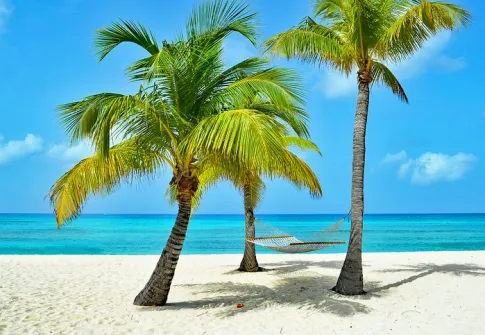Seven-Mile Beach is the busiest and most populated beach on the Cayman Islands. Cayman Islands Tourism Vacations Travel. On the northern coast of Grand Cayman and the southwest corner of Cayman Brac, less crowded beaches can be found. The Cayman Islands are one of the best diving locations in the Caribbean. Traditional West Indian culture is more strongly represented on Little Cayman and Cayman Brac.
Why Travel to the Cayman Islands
Travelers looking for adventure and relaxation continue to adore the picturesque Cayman Islands, which are located in the Caribbean. As rum punch calls to beach loungers, coral reefs and shipwrecks call to divers. Couples go on a romantic stroll along the 200-year-old Mastic Trail while their parents take their kids to Stingray City for an interactive swim. The Cayman Islands are happy to help you relax however you like.
Cayman Islands Travel and Tourism Vacations
Three islands make up the Cayman Islands archipelago, which is located 150 miles south of Cuba. For those who like preplanned itineraries and don’t mind sharing the attractions with cruise crowds, the largest, Grand Cayman, is packed of massive resorts with all-inclusive alternatives. The diving in the Caribbean is some of the greatest on the less visited Cayman Brac and Little Cayman.
The Cayman Islands: Travel Advice
The Cayman Islands are best visited between March and June when hotel prices are at their lowest. The islands are warm all year round, with consistent highs in the 80s. The coldest months are January and February, with average lows in the upper 60s. May through October is the rainy season, however rains often only linger a few hours at a time.
The islands are protected from the yearly hurricane season, which runs from June to November, due to their location in the western Caribbean. Plan your vacation for the region’s dry season, which lasts from November to April, if you don’t want to give up the weather for a discount on hotels.
Saving Money in the Cayman Islands
- diving or not diving Diving and snorkeling equipment rentals are pricey, but half- or full-day ferry cruises can be less expensive options.
- Cayman summer Plan your trip for early spring or summer when hotel rates are up to 50% less expensive to receive the best deals.
- beachcombing for mementos Although seashells are common keepsakes, you can save money by looking for them on your own at the beach.
Culture and Customs
Swimsuits are acceptable on the beach or on cruise ships, but you should dress more professionally off the beach and in town. That is the Cayman Islands’ dress code.
The Cayman Islands dollar, which is nearly similar to the US dollar, is the country’s official unit of exchange. Be cautious to check the current conversion rate before you travel because the Cayman Islands dollar to US dollar exchange rate can change. However, major credit cards and U.S. dollars are accepted rather widely in the Cayman Islands.
Restaurants typically want a 15% tip, but be sure to carefully review the bill since gratuity may have already been included. Taxi drivers anticipate receiving a tip of between 10% and 15%. Keep in mind that the service charge at hotels typically varies from 6 to 12 percent and is normally included.
What to Eat
Your trip to the Cayman Islands won’t be complete without a healthy dose of seafood, just like in most other Caribbean locations. The restaurant Blue by Eric Ripert is arguably one of the best venues to enjoy the local seafood. According to previous customers, the famed restaurant is a splurge but well worth it if you’re looking for a long wine list because it’s located inside the Ritz-Carlton branch on Grand Cayman.
On Grand Cayman, visit Hemingways for a less formal setting. The blend of Asian and Caribbean flavors at Hemingways continues to win praise from patrons, despite the occasional DJ upsetting the ambiance of a fine dining establishment. Equally well-regarded is the Calypso Grill in West Bay, particularly for its sizable deck with views of Morgan’s Harbour. If you’re determined to eat here, previous patrons advise that you make reservations in advance. Travelers advise having lunch at Captain’s Table on Cayman Brac, which is well-known for its tacos and grouper meals.
Travelers would be remiss if they didn’t try conch stew, conch fritters, conch soup, or conch salad, but fortunately, most restaurants showcase this particular sea snail from November to April. Deep-fried dumplings called “Johnny Cakes” are another delectable dish, as is the savory jerk chicken. Try Big Tree Bbq in Gun Bay for these and other traditional foods.
And if you or your traveling companions are vegetarians or vegans, think about having a lunch at VIVO, which specializes in gluten-free, organic, vegetarian, and vegan fare. The meals produced with coconut, such as the coconut ceviche, which is made with coconut “bacon,” and the “calamari,” which is deep-fried young coconut prepared in the style of calamari and served with a side of hot tomato, were very well-liked by previous customers.
Safety
However, you should lock your valuables in the hotel safe for the duration of your trip because theft of small tech items like smartphones and laptops has been on the rise. Grand Cayman, Cayman Brac, and Little Cayman all have low crime rates. There are a few health concerns you should be aware of while traveling.
Mind the Sun
It might be better to take it easy on your first day at the islands because the oppressive Caribbean heat might catch you off guard. While traveling, keep in mind to wear sunglasses, drink plenty of water, and frequently apply sunscreen. This can assist you in avoiding both sunburn and heat stroke, which can cause fever, chills, headache, nausea, or dizziness.
Respect the bug
The tiny, annoying “no-see-ums,” or gnats, emerge in the Cayman Islands at dusk. Apply insect repellent and bug spray before going out for a night on the town.
Dive with care
Before doing even the most simple missions, divers in the Cayman Islands should complete the necessary training, and they should never dive alone. Keep an eye on the weather because bad currents can ruin your underwater excursion.
Decompression sickness, popularly known as “the bends,” can happen from rising too quickly to the surface and can cause nitrogen bubbles to accumulate in the diver’s blood and tissues, causing joint discomfort, itchy, swollen skin, confusion, loss of balance, and shortness of breath. Swim slowly (no faster than 30 feet per minute) and take rests when returning to the surface after longer dives. Divers strongly suggest seeking immediate medical assistance if they have decompression sickness symptoms.
Getting Around Cayman Islands
The Cayman Islands can best be explored by automobile. On Grand Cayman, rental companies are located directly across the street from Owen Roberts International Airport (GCM), and taxis may be found in the airport’s arrivals area. Depending on where your hotel is located, the cost to get there can vary greatly; budget at least $20 for the trip.
The smaller Cayman Brac and Little Cayman provide rental automobiles and mopeds as well. You can take a private boat from Grand Cayman to either of the islands; Cayman Brac and Little Cayman also have their own airports with regular flights run by Cayman Airways.
Entry and Exit Requirements
To enter the Cayman Islands, every American citizen must have a current passport. For passengers 12 and older, a departure tax is charged in addition to the airfare. Visit the U.S. Department of State website for more details on the rules for admission and leave.



